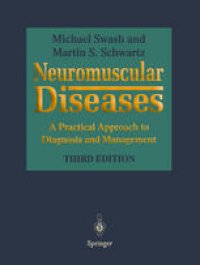
Ebook: Neuromuscular Diseases: A Practical Approach to Diagnosis and Management
- Tags: Neurology, Rheumatology, Pathology
- Year: 1997
- Publisher: Springer-Verlag London
- Edition: 3
- Language: English
- pdf
Nine years have elapsed since the second edition of this book was published. In this time the principal advances in neuromuscular diseases have been in the application of molecular genetics to understanding the aetiology and pathogenesis of this group of disorders. As a result many previously unrecognised disorders have been charac terised. Some clinical syndromes, such as the limb girdle dystrophies, have become better defined. In many such instances the new genetic information has led to major advances in knowledge of the biology of cell structures, for example, the membrane structural and channel proteins. The clinical syndromes themselves, and their patho logical and electrophysiological characteristics, however, remain as important as ever, since they constitute the clinical problem itself and, indeed, the database from which all other concepts emerge. Knowledge of the pathogenesis, genetics, and molecular biology of neuromuscular disorders is essential both in developing and applying new therapies and preventive measures, and in formulating genetic and prognostic advice. However, this informa tion does not necessarily always define clinically useful syndromes. Myotonia, for example, is an electrophysiological finding in some syndromes in which it is un detectable by clinical examination, although the phenomenon itself was originally defined as a clinical entity. The limb girdle muscular dystrophy syndromes can be defined by severity, distribution of weakness, age of onset, sex distribution and other characteristics and many of these can be better understood by study of the under lying defect in cell structural proteins.
This is the third edition of Neuromuscular Diseases, containing extensive revision and rewriting to take account of the major advances that have occurred in the field of neuromuscular diseases, but following the same basic plan as the earlier editions. The aims of this new edition remain unchanged: indeed it is felt to be more important than ever to correlate the different categories of information about neuromuscular diseases into an account that allows clinicians to understand their patients' problems, and to plan appropriate investigation and management. Many new references have also been added. This book should provide a convenient source of practical and theoretical information that will be useful to managing patients with neuromuscular problems. Both authors are recognised experts in the field of neuromuscular disorders and the book is based o n their extensive and continuing clinical and research experience.